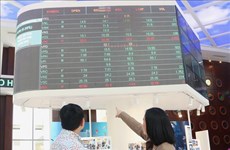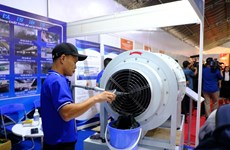Vietnam poised as a winner from FTAs
Vietnamese economy is expected to make strong growth following a number
of free trade agreements (FTA) coming into effect in the near future,
said radio The Voice of Vietnam (VOV).
Vietnamese economy is expected to make strong growth following a number
of free trade agreements (FTA) coming into effect in the near future,
said radio The Voice of Vietnam (VOV).
The trade pacts, once signed, will open up new opportunities for high quality Vietnamese products to integrate deeply into the global market while helping the country reduce its overdependence on certain markets.
Most notably among them is the Trans-Pacific Partnership (TPP) agreement, which is currently in its 20th round of negotiations.
Member countries are currently negotiating to eliminate 100 percent of tariffs on imports, of which 90 percent of the tariffs will be abolished immediately with the remaining 10 percent removed following a moratorium period of up to 10 years.
TPP member countries account for 40 percent of global GDP and 30 percent of the total global import-export revenue.
Once the agreement is signed, Vietnamese products will have ample opportunities to deeply penetrate large markets including the US , Canada , Mexico and Japan on a more equal playing field with other countries around the globe.
The Vietnamese garment sector is expected to cash in on the TPP agreement. Roughly 1,000 tax lines on garment products exported to the US will be slashed to zero from the current 18 percent. Garment exports may surge 15-20 percent annually and may reach 50 billion USD by 2025 according to some optimistic forecasts.
However, to benefit from the trade pact, the garment sector must meet certain conditions, such as certificate of origin on materials used in the intra-bloc.
Secretary General of the Vietnam Textile and Apparel Association (Vitas) Dang Phuong Dung says this is not necessarily going to be an easy task.
Garment businesses must renovate technology, invest in material production, create closed process ranging from fibre, textile, dying and garment, and raise the proportion of domestic material use and added value for products to grasp TPP’s advantages, Dung says.
The most challenging requirement for Vietnam is to make products from domestic materials, and to do this, Dung says, the sector has no choice but to develop material growing areas.
In addition, she adds, Vitas is preparing to train and shift from doing outsourcing to modern production methods to increase added value for products.
This year, Vietnam is also negotiating a number of other important FTA agreements including one with the European Union, the Republic of Korea , and the Customs Union (Russia-Belarus-Kazakhstan).
These agreements will help Vietnam expand its export markets, especially for agricultural products, and reduce its overdependence on the Chinese market.
Chairman of the Vietnam International Arbitration Centre Tran Huu Huynh says strict requirements from these agreements force domestic businesses to improve their competitiveness to join the global value chain.
“These agreements will offer both opportunities and challenges for them to rise up,” Huynh said.
On the other hand, Vietnam ’s imports will also enjoy benefits from these agreements. State-of-the-art machinery and equipment will be readily available for import at reasonable prices.
Machinery and equipment imports from the EU rose from 2.6 billion USD in 2005 to 7.6 billion USD in 2010. Tariff cuts will help Vietnam import yet even higher quality machinery and equipment at lower prices, gradually facilitating a reduction in the trade deficit with China .
Vietnam is actively negotiating to finalise the free trade agreements to support businesses in expanding markets overseas in the future.
Minister of Industry and Trade Vu Huy Hoang says the Government’s guideline is to diversify new import-export markets to avoid overdependence on any one partner to the greatest extent possible.
“The Government will create a niche for businesses to accelerate exports more stably and sustainably,” Hoang notes.
Experts warn that when trade pacts are signed, Vietnam should develop promotion programmes for each field, draw up detailed plans for material growing areas and sustainably develop the support industry.
The Government should also soon issue support policy guidelines for garment, footwear and agricultural businesses to fully exploit advantages from FTAs.-VNA
The trade pacts, once signed, will open up new opportunities for high quality Vietnamese products to integrate deeply into the global market while helping the country reduce its overdependence on certain markets.
Most notably among them is the Trans-Pacific Partnership (TPP) agreement, which is currently in its 20th round of negotiations.
Member countries are currently negotiating to eliminate 100 percent of tariffs on imports, of which 90 percent of the tariffs will be abolished immediately with the remaining 10 percent removed following a moratorium period of up to 10 years.
TPP member countries account for 40 percent of global GDP and 30 percent of the total global import-export revenue.
Once the agreement is signed, Vietnamese products will have ample opportunities to deeply penetrate large markets including the US , Canada , Mexico and Japan on a more equal playing field with other countries around the globe.
The Vietnamese garment sector is expected to cash in on the TPP agreement. Roughly 1,000 tax lines on garment products exported to the US will be slashed to zero from the current 18 percent. Garment exports may surge 15-20 percent annually and may reach 50 billion USD by 2025 according to some optimistic forecasts.
However, to benefit from the trade pact, the garment sector must meet certain conditions, such as certificate of origin on materials used in the intra-bloc.
Secretary General of the Vietnam Textile and Apparel Association (Vitas) Dang Phuong Dung says this is not necessarily going to be an easy task.
Garment businesses must renovate technology, invest in material production, create closed process ranging from fibre, textile, dying and garment, and raise the proportion of domestic material use and added value for products to grasp TPP’s advantages, Dung says.
The most challenging requirement for Vietnam is to make products from domestic materials, and to do this, Dung says, the sector has no choice but to develop material growing areas.
In addition, she adds, Vitas is preparing to train and shift from doing outsourcing to modern production methods to increase added value for products.
This year, Vietnam is also negotiating a number of other important FTA agreements including one with the European Union, the Republic of Korea , and the Customs Union (Russia-Belarus-Kazakhstan).
These agreements will help Vietnam expand its export markets, especially for agricultural products, and reduce its overdependence on the Chinese market.
Chairman of the Vietnam International Arbitration Centre Tran Huu Huynh says strict requirements from these agreements force domestic businesses to improve their competitiveness to join the global value chain.
“These agreements will offer both opportunities and challenges for them to rise up,” Huynh said.
On the other hand, Vietnam ’s imports will also enjoy benefits from these agreements. State-of-the-art machinery and equipment will be readily available for import at reasonable prices.
Machinery and equipment imports from the EU rose from 2.6 billion USD in 2005 to 7.6 billion USD in 2010. Tariff cuts will help Vietnam import yet even higher quality machinery and equipment at lower prices, gradually facilitating a reduction in the trade deficit with China .
Vietnam is actively negotiating to finalise the free trade agreements to support businesses in expanding markets overseas in the future.
Minister of Industry and Trade Vu Huy Hoang says the Government’s guideline is to diversify new import-export markets to avoid overdependence on any one partner to the greatest extent possible.
“The Government will create a niche for businesses to accelerate exports more stably and sustainably,” Hoang notes.
Experts warn that when trade pacts are signed, Vietnam should develop promotion programmes for each field, draw up detailed plans for material growing areas and sustainably develop the support industry.
The Government should also soon issue support policy guidelines for garment, footwear and agricultural businesses to fully exploit advantages from FTAs.-VNA













